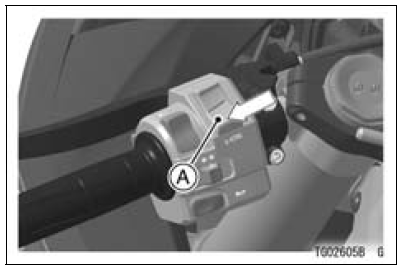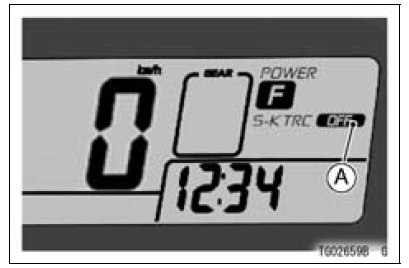

S-KTRC is an intelligent system that calculates the slip level of the rear wheel (wheelspin) and is suitable for sports riding conditions. S-KTRC is designed to function on public roads.
Acceleration may be delayed under certain circumstances depending on road conditions. S-KTRC cannot respond to every condition.
| WARNING S-KTRC cannot protect the rider from all possible hazards and is not a substitute for safe riding practices. All riders must be aware of how the S-KTRC system operates and its limitations. It is still your responsibility to ride at appropriate speeds and throttle control for weather, road surface and traffic conditions. |
The S-KTRC functions at 5 km/h (3.1 mph) or more, and stops functioning at 4 km/h (2.5 mph) or below.
| WARNING Use of nonrecommended tires could cause a malfunction or improper operation of S-KTRC. Always use recommended standard tires for this motorcycle. |
MODES
The S-KTRC determines the traction control characteristics with three mode selections. The S-KTRC can also be set to OFF.
The S-KTRC and the Power mode can be set separately. By combining each setting, the rider can get various riding feelings.
MODE 1:
The S-KTRC least intervenes among the three modes. This makes lengthy drifts and wheelies possible when exiting tight corners.
MODE 2:
There is more S-KTRC intervention compared tomode 1. Thismakes slight drifts possible when exiting tight corners.
MODE 3:
The S-KTRC intervenes early enough to prevent the rear wheel from spinning whenever possible.
[Example]
(Actual ranges vary with rider skills)

S-KTRC Button
Use the S-KTRC button on the left hadle switch to set the S-KTRC mode.

A. S-KTRC Button (Lower Part)
Themode can be changed only when the throttle grip is closed completely.
NOTE
When changing the mode, stop the motorcycle.
 0.4
0.4

NOTE

A. S-KTRC OFF Indicator
NOTE
 Catalytic Converter
Catalytic Converter Power mode
Power modeTurn Signal Relay Inspection
Remove the battery (see Battery Removal).
Take the turn signal relay [A] off the rear fender.
Disconnect the connector [B].
Connect one 12 V battery and turn signal lights as indicated
in the figure, and count how many times the lights
blink for one minute.
Turn Signal Relay ...
Wear Inspection
Remove the left front footpeg bracket
bolts.
A. Front Footpeg Bracket
B. Bolts
Remove the bolts and chain cover.
A. Bolts
B. Chain Cover
Stretch the chain taut either by using
the chain adjusters, or by hanging a
10 kg (22 lb) weight on the chain.
Measure the lengt ...
Subthrottle Sensor Input Voltage Inspection
NOTE
Be sure the battery is fully charged.
Turn the ignition switch to OFF.
Remove the air cleaner housing (see Air Cleaner Housing
Removal in the Fuel System (DFI) chapter)
Disconnect the subthrottle sensor connector and connect
the harness adapter [A] between these connectors.
Spec ...